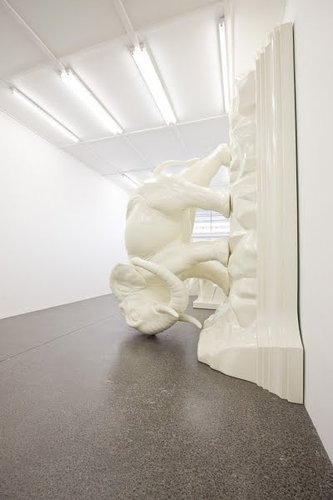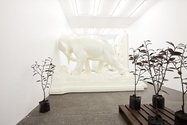John Hurrell – 2 December, 2009
These straining hefty beasts also allude to The Moment of Cubism and seem to be attacking the modernist ‘white cube’ – as exemplified by Lett’s gallery space. The revenge of the colonised?
This show is dominated by Parekowhai’s oblique but clever title which refers to the fraught relationship between early modernism (particularly cubism) and various ‘primitive’ African cultures that influenced it (or which were ‘appropriated’). The eponymous work consists of seven bronze-cast lemon saplings standing on or around a bronze pallet, as if in a nursery. The plants, all of different heights, bear none of their characteristically bitter fruit, but the lemons’ absence is artificial and so, conspicuous – a negative symbol for suppression. (As opposed to ‘repression’ which is an organism’s internal mental or bodily restraining mechanism. Why do I mention this? Because the show is about the politics of art history, not modernism critiquing itself. If it were the latter, my title would have been ‘the rise of the repressed’.)
Lemons are also a symbol for power – as in electrical energy. They (because of their acid) can literally be used to create batteries that generate electricity. The missing fruit can also become a metaphor for the ‘missing’ African sculpture that was essential in the growth of cubism.
In Parekowhai’s hands they take on the meaning of political power too. That of the colonised, which many might claim was not properly acknowledged, and so made invisible - but now asserting its presence. (See the famous, very heated Thomas McEvilley versus William Rubin and Kirk Varnedoe Primitivism debate in artforum Nov. 1984 and Feb. 1985)
The two other works are more physically imposing - three dimensional, African animal forms linked to ebony bookends. These are creamy, off-white, hugely enlarged elephants and impala and the bookends are symbollically what contain the documentation and interpretation of western art history and its visual culture.
Whereas the original small black ‘African’ bookends are usually slightly angular with crisp wooden edges, these fibreglass whoppers have a soft, liquidly flowing quality, as if made of oozing custard or cream. The antelope works Seldom is Herd, has three parts – strange for bookends (one grazing deer is duplicated) but linked to the title which of course plays off the fruitless lemon trees.
The two very large elephant bookends are called Te Ao Hurihuri which apparently means ‘The World Keeps Turning’. Perhaps it is saying ‘nothing changes’? The title might refer to the fact that one is horizontal, (exasperatedly?) pressing its head against the wall, and the other is tipped up so its head is against the floor, as if the gallery has been spun around. These straining hefty beasts also allude to The Moment of Cubism and seem to be attacking the modernist ‘white cube’ – as exemplified by Lett’s gallery space. The revenge of the colonised. A counter-attack by the appropriated.
This is a particularly clever show from Parekowhai in the way all the components conceptually interconnect. Visually however the dark brown bronze plants seem a little strange juxtaposed with the milky fibreglass animals, despite the common historical socio-ethnic content. They look almost an afterthought but one rescued by the brilliantly pithy title. Yet if you think through and around the elements, as I think I have done, it all adds up – a very successful (but entertaining) post-colonial critique of modernist gallery architecture and its attendant art history.
(Since I wrote this it has been pointed out that the animals are based on Wedgwood ornaments, so any mention of ebony statues is obviously mistaken. The whole discussion needs a rethink.)
Recent Comments
John Hurrell
The Parekowhai show can be pondered over with the Berger and Wedgwood references being somehow connected...perhaps? In truth I'm not ...
Deborah Cain
On cubism and primitivism etc: you can listen to the first talk by Paul Wood on "Art & Globalisation" in ...
Boris
tip: THE MOMENT OF CUBISM also is an essay by John Berger from 1969.




 Advertising in this column
Advertising in this column Two Rooms presents a program of residencies and projects
Two Rooms presents a program of residencies and projects



This Discussion has 9 comments.
Comment
Stephen, 11:48 a.m. 5 December, 2009 #
Oh, also, can you expound and elaborate on how Parekowhai’s "oblique but clever title" refers to the fraught relationship between early modernism (particularly cubism) and various ‘primitive’ African cultures that influenced it?
Stephen, 11:40 a.m. 5 December, 2009 #
I wonder if "The World Keeps Turning" refers to the common proverb which more-or-less means "bad stuff happens to you, and me, and everyone, but the world still keeps turning and none of it matters in the end" [sic]; a convoluted way of saying "shit happens".
It's also a song variously by Napalm Death, Tom Waits, and Fleetwood Mac.
Guess I'll give this one a miss though -- I'm afraid the very idea of "post-colonial critique of modernist gallery architecture and its attendant art history" makes something inside me want to shrivel up and die with embarrassment.
John Hurrell, 11:51 a.m. 5 December, 2009 #
Let me stress the above reading of the M.P. show is my interpretation only. Others may think I've got it utterly wrong. I'm speculating. (As I often do.)
To very briefly elaborate,Picasso and Braque referenced various central African (and Egyptian) masks and statues in their early explorative cubism (esp. 1906-8) and for some people it is a highly sensitive issue because no permission or dialogue was involved - seemingly much like Gordon Walters' use of the koru in this country. Therefore lemon trees without bitter lemons can be read as a form of denial, a symbol for some unacknowledged grievance - especially in a show also having references to carved African animals that have been enlarged and made white, and the exhibition's very specific title.
The McEvilley essay on MOMA's Primitivism show is a great read on this topic, in November 1984's artforum, as are also Rubin's and Varnedoe's responses in Feb 1985.
Didn't know about that song you mention, though I do follow Tom Waits quite closely. A version of Que Sera,Sera...perhaps?
Stephen, 11:51 a.m. 5 December, 2009 #
Thank you, yes, but is "The Moment Of Cubism" a pun of sort sort?
John Hurrell, 11:51 a.m. 5 December, 2009 #
Could be. Cubism is about simultaniety (multiple viewpoints at the same instant)- as opposed to say Futurism which is more about movement.
Boris, 11:52 a.m. 5 December, 2009 #
tip: THE MOMENT OF CUBISM also is an essay by John Berger from 1969.
John Hurrell, 11:51 a.m. 5 December, 2009 #
Somebody has just told me of the thirties Wedgewood series of porcelain animal bookends, so my theory above turns to custard.
Any readers an authority on Wedgewood?
Deborah Cain, 5:39 p.m. 7 December, 2009 #
On cubism and primitivism etc: you can listen to the first talk by Paul Wood on "Art & Globalisation" in the Tate Open University series, where he talks about the early 20th century avant-garde, see website [with video link] http://www.tate.org.uk/learning/studydays/globalisation/
John Hurrell, 5:40 p.m. 7 December, 2009 #
The Parekowhai show can be pondered over with the Berger and Wedgwood references being somehow connected...perhaps? In truth I'm not sure now about the extent of its focus. Be curious to hear some other opinions on this.
Participate
Register to Participate.
Sign in
Sign in to an existing account.